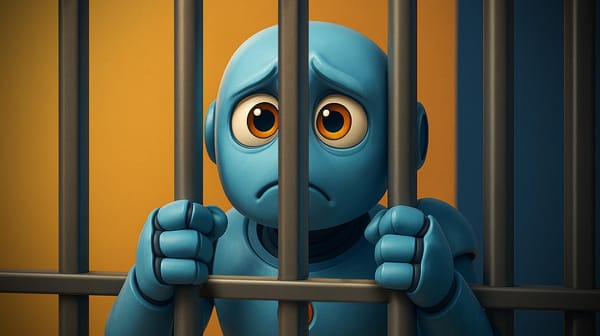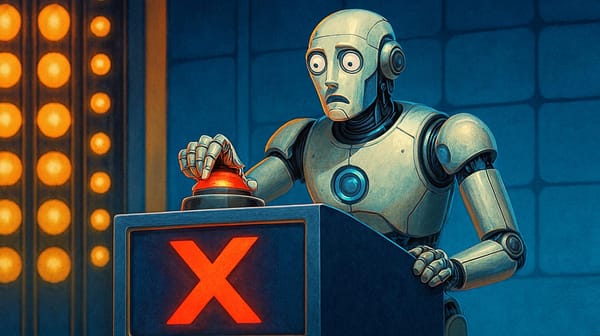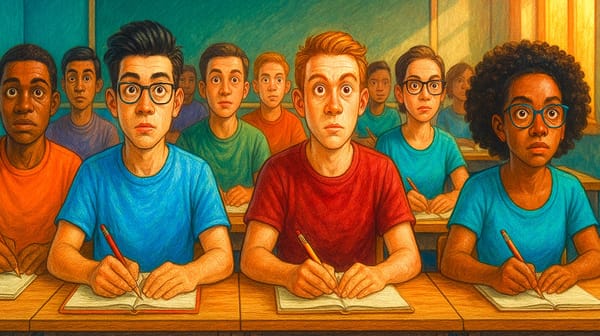Adobe Takes on Everyone in AI
The creative heavyweight is now battling in every corner of the marketing universe. How do the odds stack up?

I remember the first time I cracked open a Photoshop 3.0 manual. It was 1994, I was a scrappy young marketer, and I’d spent half my savings on Adobe’s revolutionary software. I didn’t know it then, but I was stepping into a creative ecosystem that would carry me through print campaigns, website launches, stock photography hunts, and eventually full-blown digital content creation. Adobe was always in the background, powering my professional life like a steady drumbeat.
Fast-forward to 2023, and many of us—myself included—wondered if the sun was finally setting on Adobe’s empire. New AI disruptors seemed to pop up daily, each promising to turn text prompts into polished images, videos, layouts, or entire marketing plans. Adobe’s shining Creative Cloud began to feel a bit… obsolete. But beyond the creative toolbox, the company has been quietly building a giant with its Adobe Experience Cloud and its own vision of an AI-first future.
At last week's Adobe Summit 2025, the digital giant stole the spotlight from the usual AI headliners, announcing a lineup of next-gen offerings that feels like a declaration of war—on everyone. From enterprise titans like Salesforce to the legions of low-cost, niche AI tools, Adobe’s evolving AI arsenal is putting the entire marketing and creative landscape on notice.
It's a bold move for sure. But as it takes on every competitor, category by category, how does Adobe really stack up?
AI Agents: Adobe vs Salesforce and Microsoft
The big news at last week’s Summit: Adobe unveiled its plans to define Customer Journey Orchestration in the era of AI. What exactly does this buzzword salad mean? It means Adobe has entered the "AI agent" fray, joining Salesforce and Microsoft. In this case, Adobe's new autonomous assistants are designed to handle everything from building microsites to repurposing creative assets. A demonstration showed how an AI agent could assemble a fully personalized webpage in minutes—fetching images from Firefly, pulling product data from Adobe Experience Platform, and pushing the final design live in Experience Manager.
Adobe's agents are primarily focused on predicting user behavior, fixing website issues, creating targeted content, and optimizing marketing campaigns. In contrast, Salesforce's Agentforce is a platform for building and customizing autonomous AI agents for customer service, sales, and marketing. And Microsoft's Copilot is a broader business assistant for tasks like coding, writing, data analysis, and more. Lots of overlap, but each plays to the strengths of it own ecosystem.
Who Wins?
- Enterprise customers already getting value out of Adobe Experience Platform will be able to tinker with just-out-of-beta agents and explore the promise of exponential productivity gains.
- Agentforce and Copilot users pretty much get to do the same thing, just on different platforms.
The verdict here: Every major marketing and sales platform is going all-in on agents this year. Each will have a major announcement and take credit for revolutionizing the future of work. Then, each will be subject to real-world testing. It's early days, so you probably don't want this to be your only reason for choosing between them.
Visual Generation: Adobe Firefly vs Midjourney and Sora
When Adobe first introduced Firefly in 2023, it pitched it as a commercially safe alternative to the likes of Midjourney or OpenAI’s DALL·E. This week, Adobe upped its game further, announcing new Firefly video capabilities—including a Translate & Lip Sync feature for video content and a Reframe tool that automatically resizes video assets for all social platforms. They’re calling Firefly’s latest iteration the first “enterprise-ready” generative AI service for video.
If that sounds like a direct challenge to every generative video player on the scene (Runway, Synthesia, you name it), well, it probably is. Adobe is positioning Firefly as the “safe and consistent” solution for big brands. It’s brand-safe because it’s trained on Adobe Stock and public domain materials, with no questionable Internet-scraped IP that might spark legal troubles down the road. That might not matter to indie creators fiddling with edgy Midjourney prompts. But if you’re Coca-Cola or Nike, you’d rather trust an AI with bulletproof licensing and an indemnification promise than a black-box model from a scrappy startup.
Who wins?
- If you want the most jaw-dropping, borderline-psychedelic visuals, Midjourney delivers.
- But if you’re an enterprise that needs brand consistency, IP safety, and instant integration with tools like Premiere Pro or After Effects, Firefly is a very real—and possibly unstoppable—player.
In other words, for big-budget marketing, Adobe just gave creators a strong reason not to wander off into alternative AI image or video tools.
Enterprise Marketing Cloud: Adobe Experience Cloud vs. Salesforce and Microsoft
In the race to dominate AI-powered marketing, Salesforce has Einstein GPT, a human-assisted productivity partner and Agentforce, its autonomous counterpart. Microsoft has responded by weaving AI into its vast productivity ecosystem with Microsoft 365 Copilot, integrating GPT-4 features into Teams, Outlook, PowerPoint, and more.
Adobe answered this week with new Adobe Sensei GenAI capabilities within Adobe Experience Cloud, powered by Adobe Firefly (rolls right off the tongue, doesn't it?). Firefly is Adobe’s generative AI engine for producing images, text effects, and other creative assets at scale while adhering to brand guidelines. In practice, a marketer can type, “Generate 30 social ad variations for this campaign,” and let Firefly handle everything from visuals to copy, all tied into Adobe Analytics for real-time performance data.
Salesforce might still take the lead on deep CRM intelligence, while Microsoft leverages its massive footprint to introduce AI features into everyday workflows. But Adobe owns the creative pipeline end to end. You can ideate designs in an AI-enabled Adobe Express or Photoshop (with Firefly integration), then seamlessly launch campaigns in Experience Manager, all within the same ecosystem ... provided you can keep the names of the tools straight.
Who wins?
- If your primary need is generating quick email sequences or data-driven segmentation, Salesforce or Microsoft has you covered. It's worth mentioning that Adobe Express integrates with both ecosystems as well.
- But if your marketing team needs an all-in-one platform that marries creative production with enterprise marketing tools, Adobe’s unified Experience Cloud (again, powered by Sensei GenAI and Firefly) may have the edge.
Ultimately, it comes down to whether you want best-in-class CRM and productivity features—or a deeply integrated creative pipeline that handles everything from concept to final campaign. Adobe is betting on the latter as a game-changer for marketers.
DIY Design: Adobe Express vs. Canva
In the early days, Canva was dismissed as the “cute little design tool” for non-designers. Now it’s a behemoth boasting over 130 million users and an AI suite called Magic Studio that can generate designs, convert them into multiple formats, and even produce short videos. Meanwhile, the average social media manager at a small brand often says, “We just use Canva,” leaving Adobe out in the cold.
Both tools continue to lower the barrier to entry for professional quality design. But let's be honest, the differences in features are slim. If anything, Adobe is playing catch up, as Canva has a rabid fan base, unstoppable word-of-mouth, and a major head start in the "everybody's a designer" space.
Who Wins?
- For content creators serving small agencies and brands, Canva is the no-fuss design tool of choice.
- For any mid-sized or larger business that can’t risk brand misfires, Express + Firefly can auto-generate visuals in an on-brand color palette, typeface, and style.
The subtext here? Both tools continue to match each other feature for feature, with AI piling on even more productivity and creative power. For many, the choice will come down to personal preference.
It's an Enterprise Thing
One thread that ties Adobe’s announcements together is brand safety and ethical AI. Firefly only uses licensed and public domain data; Adobe even indemnifies enterprises if they get sued for AI-generated content. Plus, features like Content Credentials let you track whether an image or video was AI-generated.
If you’re Coca-Cola or a Fortune 500 insurance giant, that’s a game-changer. Enterprise legal teams have been skittish about generative AI because no one wants to be the test case for a copyright lawsuit. Adobe says, “We’ll handle it.”
On the flip side, your average freelance creator or small business isn’t typically worried about being sued by a random stock-photo photographer—especially if they’re saving $50+ a month skipping Creative Cloud. They might care more about raw generative quality, fancy stylization, or easy drag-and-drop. In that realm, Adobe still faces competition from cheaper or free AI tools that might be “less ethical” but produce fast results.
Ultimately, though, the enterprise space is where massive deals get struck—and Adobe knows it.
The Defense
Let’s not forget that Adobe is still a creative juggernaut. Despite decades of new challengers, Photoshop, Illustrator, InDesign, and Premiere Pro remain industry standards. In marketing automation, Adobe’s share is smaller than Salesforce’s, and in the data cloud wars it can’t compare to Google or Microsoft. But Adobe has carved out a unique stronghold at the nexus of marketing and creative.
According to various market estimates, Adobe Experience Cloud holds around 10–12% of the marketing automation space (lagging Salesforce’s ~20% share), while Creative Cloud dominates roughly 80–90% of professional design workflows. For mid-sized agencies, that number is lower—Canva’s infiltration is real. But for large-scale brand campaigns, Adobe is still the 800-pound gorilla, now outfitted with AI upgrades.
Combine that with Adobe’s new AI announcements—Firefly for video, Agent Orchestrator for marketing workflows, brand-safe image generation—and it’s clear the company is serious about defending its territory. If these bets pay off, Adobe could solidify itself as the default enterprise platform for creative and marketing AI at scale.
The Takeaway for Marketers?
It all depends on your size, budget, and goals:
Enterprise Marketers: If you’ve got compliance officers breathing down your neck, Adobe’s brand-safety shield is a big deal. Having integrated creative and marketing automation in one secure ecosystem might justify Adobe’s premium pricing.
Mid-Market Companies: You could go either way. Canva plus a third-party AI (like ChatGPT or Jasper) might suffice for smaller campaigns. But as you scale, the need for on-brand consistency and deeper orchestration may push you toward Adobe’s world.
Agencies & Creatives: Adobe’s Firefly expansions can drastically cut the grunt work of resizing, localizing, or iterating designs. But the truly artistic folks might still prefer specialized AI tools for their pure flair—and just port those visuals into Photoshop later.
Small Businesses & Freelancers: You might not care about IP safety or brand orchestration. If the best (and cheapest) tool for you is Midjourney or ChatGPT, you’ll likely stick there. Adobe’s big announcements won’t change your world overnight.
If You Ask Me
I haven’t always stayed loyal to Adobe over the years. I’ve flirted with free open-source graphics tools, hopped on the Canva train for quick social posts, and let ChatGPT handle my first-draft copy. But there’s an undeniable comfort—and maybe a touch of nostalgia—in seeing Adobe rise to the AI challenge with such force.
Adobe’s new announcements signal it’s not content to remain a legacy giant while the rest of the tech world storms past. Instead, it’s the Goliath stepping onto a battlefield teeming with rival Davids—and Goliaths of its own size, like Salesforce and Microsoft. Will it trample them all, or get toppled by a fresh wave of disruptors?
Time will tell, but for now, Adobe is putting its foot down and claiming it can do enterprise AI better than everyone else. In a universe overflowing with half-baked AI solutions, that bold stance might just win over the brands who have everything to lose—and the marketing teams who remember exactly which company powered their first real creative spark.
Welcome back to the fight, Adobe. We’ve missed you.






